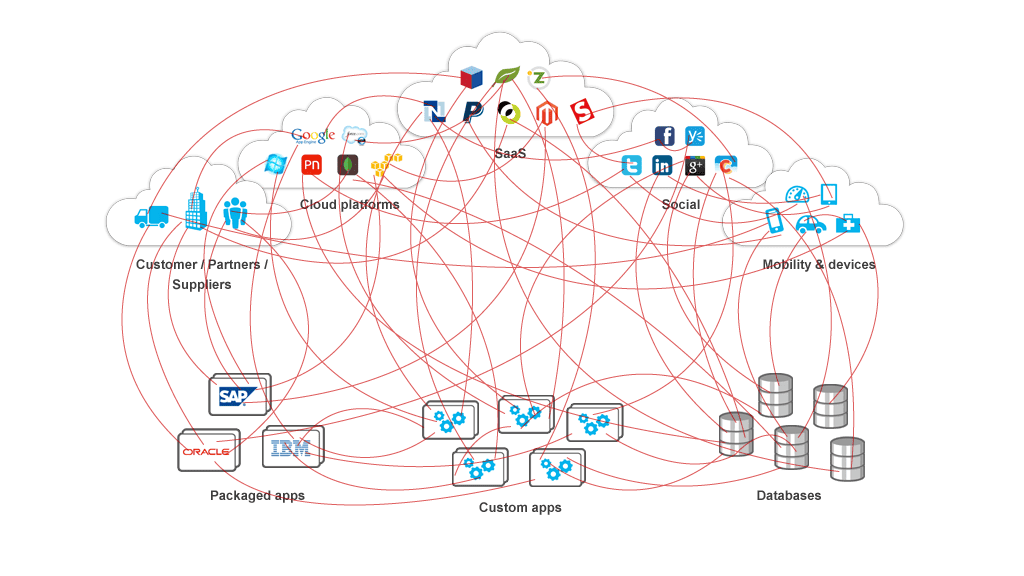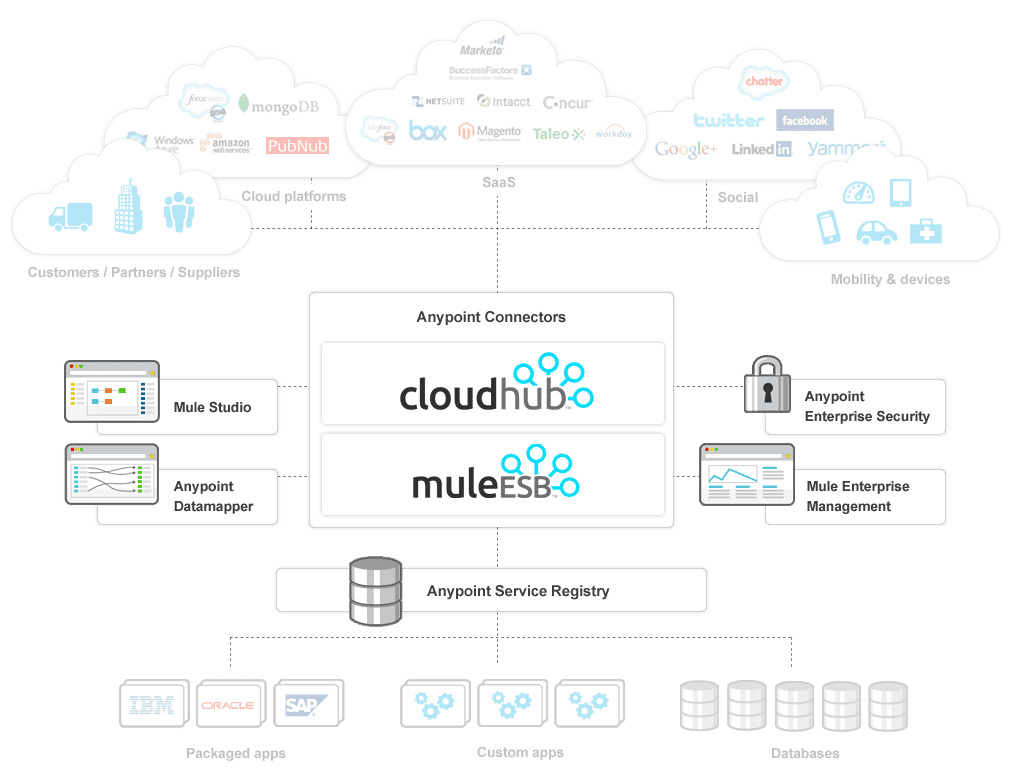Enterprise connectivity solutions
The enterprise landscape is changing. Enterprises once defined by the applications within their data centers are now connecting to SaaS applications beyond the constraints of their four walls, presenting the need for connectivity. These systems require connectivity not only internally, but also to external applications and services. Creating connectivity between data sources and applications has always been a challenge for businesses and the challenge is only growing more complex.

The explosion of cloud, SaaS and mobile applications, as well as the increase in popularity of APIs has led to the era of highly fragmented environments in which best-of-breed applications and services are being leveraged to run business processes. Organizations using these applications are disrupting the traditional ways of doing business and changing the way enterprise ecosystems are structured. Moreover, with the increase in popularity of SaaS and mobile usage, the way in which consumers are interacting with businesses is changing. The number of platforms businesses use to engage their customers and deliver services is increasing and we see a surge in mobile and tablet usage - both by consumers and the workforce. Businesses need to be wherever the consumer is and more importantly, they must be able to create a great experience for their customers wherever they are.

With the emergence of so many endpoints in the enterprise, creating connectivity is becoming even more difficult. Those who can connect the enterprise and connect it well will have a competitive advantage over those who don’t. Connecting well means creating robust and future-proof connections between traditional apps, custom apps and legacy systems; organizations who can do this are the ones that will be able to reach more consumers and react more quickly to change. Moreover, considering 74% of companies are running SaaS applications1, if businesses are not using SaaS now, chances are that they will in the future.
Point-To-Point integration is evil
To address the challenges associated with a fragmented environment, many organizations have implemented point-to-point integration, often unknowingly. Point-to-point integration is a approach in which developers write custom integration code directly within the application, rather than using an integration broker. Adding integration code directly into an application creates tight coupling. Repeat this over and over again and you have a complex web of interdependent systems and modifying tightly coupled applications requires significant investments of time and resources. SaaS exacerbates this problem, as applications change frequently, thereby requiring revisions in connected applications. Moreover, as the number of applications and services within the enterprise increases, point-to-point integration turns into “spaghetti code”. This spaghetti code is essentially a tangled web of brittle connections, vulnerable to breakage at the slightest bit of change. Over time, this approach becomes overly complex, fragile, and expensive to maintain.

SOA and APIs
A better connectivity strategy is a “bottom-up” approach. Unlike its more complicated counterpart, the “top-down” approach, bottom-up delivery of service oriented architecture thinks big but starts small by taking smaller delivery steps and measuring success. The top-down approach to SOA implementation was declared dead due to its inefficient, expensive, and burdensome rip and replace methods. It did, however, pave the way for better understanding of APIs and bottom-up SOA. The fundamentals of the SOA approach - loose coupling, discoverable interfaces, and reusable services - have evolved to become the central elements of API strategies.
APIs provide a more pragmatic bottom-up approach to delivering service orientation. Unlike SOA initiatives that focus on the governance of services and obtaining a key view of your landscape, APIs emphasize the importance of enabling developers to discover and use functionality and data behind an interface. The goal is to find a solution that enables enterprises to take the best practices from the web and apply enterprise-grade API strategies to achieve the promises of SOA without having to follow the complex top-down approach.
Application programming interfaces (APIs) are rising in value to businesses as they enable reuse internally and provide access to external services that enable innovation such as telephony, facial recognition, prediction, or recommendations. These APIs provide new functionality that businesses can bring into their applications to create a better user experience. Moreover, they allow enterprises to decouple complex systems through simple API interfaces and allow other users to consume them. APIs provide a new level of interactivity and a better way for developers to consume and use services behind a well-defined interface. Now, enterprises face the difficulty of figuring out how to manage, govern, and control APIs in a centralized location.
Anypoint Platform and enterprise APIs
To help deliver on the promise of service orientation, MuleSoft offers Anypoint Platform - a next generation integration platform. Anypoint Platform not only integrates applications, but helps businesses with API development, API management, and governance. MuleSoft provides a unified platform to create connectivity both on-premises and in the cloud - helping businesses get started no matter where they are along the cloud continuum. Integrating backend systems with their applications in the cloud is crucial, as most enterprises still maintain 99% of their data on-premises - much of it remaining locked up in legacy systems and applications.

Businesses today are reacting to a number of trends - SaaS, mobile, social, big data - all hitting the enterprise at once. It’s an opportunity to re-evaluate the way systems are connected and the way consumers are engaged. The companies that overcome the challenge of a highly fragmented enterprise and connect numerous endpoints, legacy systems, SaaS applications, and deliver APIs consumed by mobile applications, will be the ones that succeed. A wave of change is forcing CIOs to look past integration and think about how to evolve their business to best compete in the future. The way to compete is to connect SaaS, to reach consumers on appropriate devices, and most importantly, to loosely couple business infrastructures to respond more quickly to change - and that is what Anypoint Platform delivers.
Learn more about Anypoint Platform and how it can help connect your enterprise.
1 Clarke, Philip, and Matt Craig. Nemertes. Rep. The Nemertes Research Group Inc, 29 Jan. 2013. Web.



